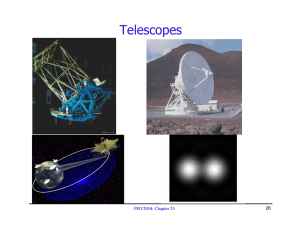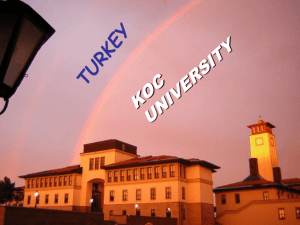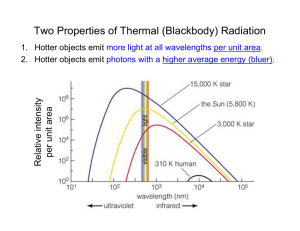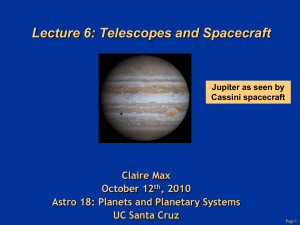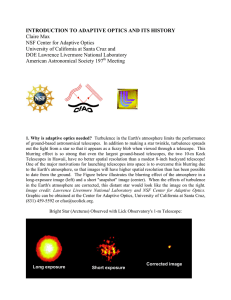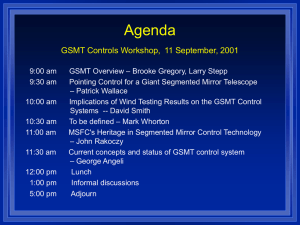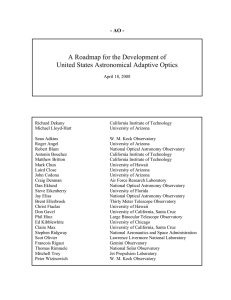Space Telescopes and Adaptive Optics
advertisement
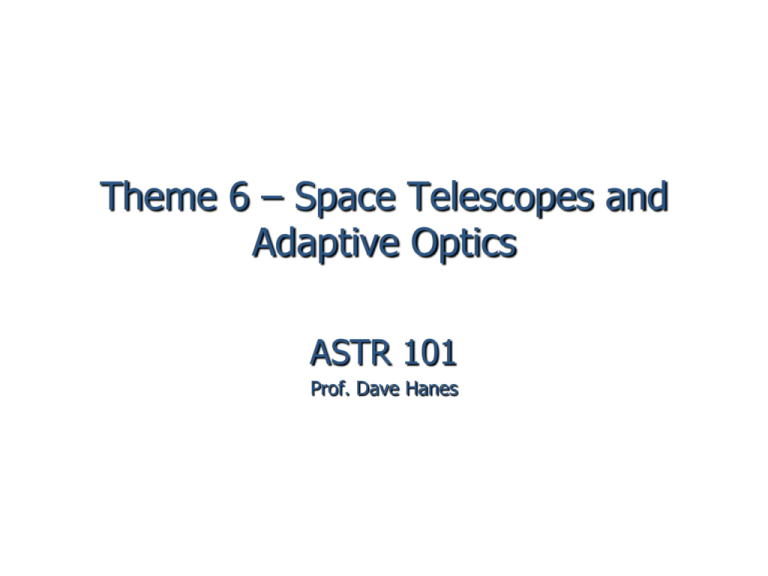
Theme 6 – Space Telescopes and Adaptive Optics ASTR 101 Prof. Dave Hanes Making Every Photon Count - and Every Dollar! 1. 2. 3. 4. 5. 6. Build bigger telescopes (to collect more light). Find the best observing sites on Earth Use ultra-efficient detectors. (Waste no light!) Study big fields of view and/or many objects at once. Launch telescopes into orbit to get the best images Use ‘adaptive optics’ to improve ground-based images (and perhaps even out-perform the Hubble Space Telescope) Photographic Plates Analog (film) vs Digital (CCDs) One Problem with CCDs: Image Scale - we need huge detectors! Mosaic Detectors Plus Photographic Plates Digital Detectors Can be made very large to take advantage of the image scale of the telescopes Some are 100-1000x as efficient as photographic emulsions Yields a stable, long-lasting (permanent?) record Give instant digital values of intensity (brightness) Easily controlled remotely Data can be transmitted and processed electronically Minus Very inefficient: at most 1% of the incoming light is recorded, so very long exposures are needed Detectors like CCDs can’t be made as big as photographic plates (but mosaics are possible) Plates require additional treatment (development, etc) and hands-on intervention The digital data has to be archived in a way that we guarantee can be read in decades to come The darkness of an image is not easily converted to a measure of intensity Data are not easily shared CCDs Permit Remote Observing - including telescopes in space Next: The Multiplex Advantage How can we study many objects at once? Of course, a direct image (i.e. a picture) already gives you many targets at once, but suppose you wanted to get a spectrum for each object? (Remember that spectra give you important astrophysical information like velocities, chemical compositions, etc.) An Exemplary Science Case [drawn from my own research] Meet a fossil: a globular cluster They contain the oldest known stars, dating back to the origin of the galaxy In Large Numbers ~150 in our own Milky Way galaxy ~1000 in ‘The Sombrero’ ~10,000 in ‘M87’ These galaxies are millions of light years away! M87 in Close-up: Many Targets How do we study them all efficiently? The goal is to learn about the mass of this galaxy (does it contain ‘dark matter’?) and its formation history. But for these very faint targets, it takes perhaps 2 hours of telescope time to get a good spectrum! Multiplex! – Using Fibre Optics Alternatively… Hubble Space Telescope: See https://www.spacetelescope.org/images/ A Rocky Beginning - the primary mirror was not the right shape! The Eagle Nebula Hubble Deep Field [and later the Ultra Deep Field] https://www.youtube.com/watch?v=le3ASDvZy_s Q: Why not study the whole sky this way? A: It would take about 13 million images! Coming: the James Webb Space Telescope The mirror will unfold in several sections (it’s too big to launch as a unit) Optimized to study infrared light Will be very far from Earth – no service missions! Adaptive Optics Remember two excellent reasons for putting telescopes into space: 1. 1. To work at inaccessible wavelengths: Chandra for X-rays; Spitzer for Infrared; Swift for gamma-rays; etc To get outside the turbulent atmosphere of the Earth: it blurs the images But problem number 2 can now be largely overcome! Why Do Stars Twinkle? Turbulence in the Earth’s atmosphere, mostly caused by warm air rising See the blurry moon at: http://www.youtube.com/watch?v=DE98X1Bv8h4 With and Without the Atmosphere Solution: Use a Small Flexible Mirror ‘Flatten the Pringles!’ Note the ‘beamsplitter’: Some light goes to the camera, for your final image (your science!). Some goes to a sensor, to measure the blurriness and control the corrections. We adjust the adaptive mirror 100 times a second! A Bright Reference Star is Needed - but not every interesting field has one Solution: Create a Star! Create an ‘artificial star’ by shooting a laser into the sky! Fire a yellow laser straight up from the telescope It encounters the ‘sodium layer’ about 90km overhead The laser stimulates the sodium ions to glow brightly Seen from the telescope, that looks like an additional bright star in the field of view The distortions and blurriness of that ‘star’ provide the information you need to correct for the turbulence of the atmosphere See a wonderful animation of the whole process at Gemini: http://www.astro.queensu.ca/~hanes/ASTR101-Fall2015/ANIMS/Gem-Adapt.mp4 The Paradox: a Light Show! Great Improvements! Ground-based telescopes have much bigger mirrors than the HST, so they can now out-perform it in visible light: they provide better resolution of details. They can also collect much more light. But they still can’t work at all wavelengths: there will always be a need for space telescopes. One Amazing Discovery Here, the VLT (Very Large Telescope) in Chile is studying the centre of the Milky Way, using a laser to permit adaptive optics. Details in the Galactic Centre Here’s a static picture in 1992. Notice all the stars near the Galactic Centre, which is about 25,000 light years away. Without adaptive optics, all these images would be blurred together. Over a Decade… Watch this animation, created from the original observations. It shows the motion of the stars (twice), then zooms in for yet another more detailed view. http://www.astro.queensu.ca/~hanes/ASTR101-Fall2015/ANIMS/MW-SMBH.mp4 The stars are clearly moving in orbits around something invisible (i.e. giving off no light). We can use our understanding of gravity to deduce that there is a very massive Black Hole (a few million times as massive as the Sun) in the centre of the Milky Way. We would not have discovered this without adaptive optics. By the way, some galaxies contain billion solar mass black holes (found in other ways). At the Center of the Milky Way !





